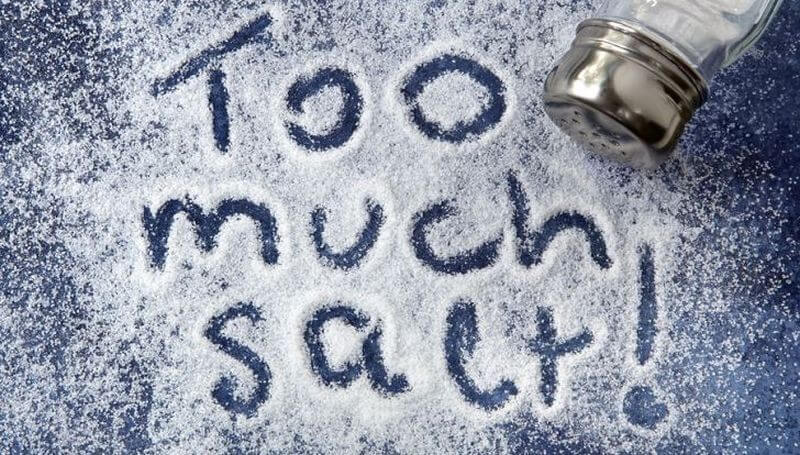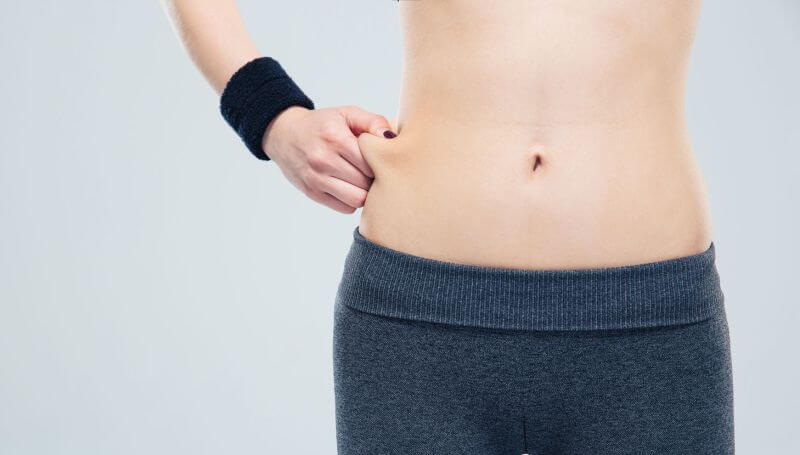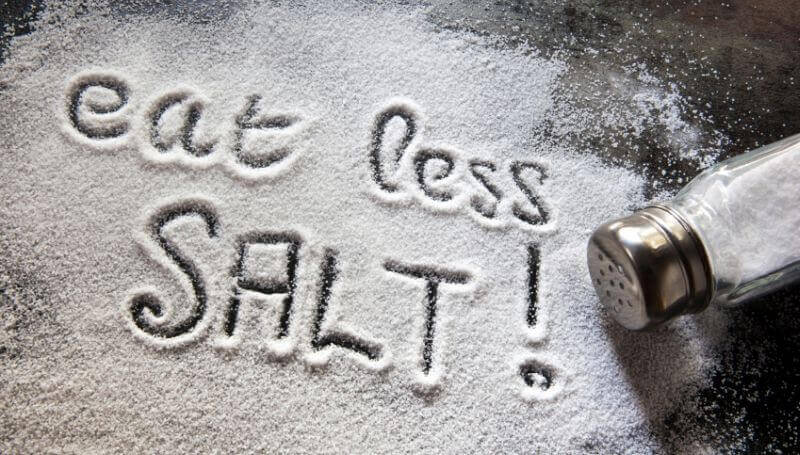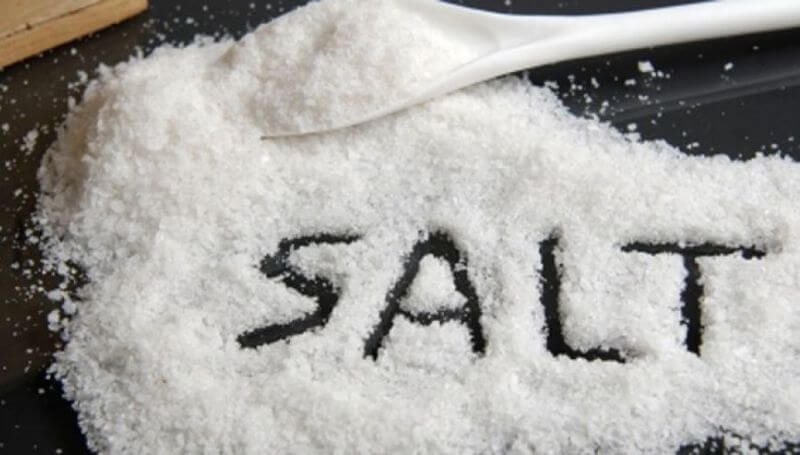Salt has been with us for thousands of years.
The Egyptians used it in religious rituals and trade.
The Greeks bought slaves with it.
The Romans paid their soldiers with it (hence the word “salary”).
European plutocracies ran on salt, Confederate troops suffered for want of it, and these days, it can be found in pantries everywhere.
Salt was once a precious resource and now it’s a humdrum condiment.
C’est la vie. 😉
Salt–the most important mineral in human history–has become even less than a lowly condiment, actually.
It’s now one of the most demonized nutrients in our modern diets.
The US government has been warning us about the (supposed) dangers of salt for decades now, which include an increased risk of heart disease and stroke.
Newer research casts doubt on these assumptions, though, suggesting that it may not be as harmful as we once believed.
Well, in this article, we’re going to break it all down and learn…
- What sodium is.
- Why sodium is (apparently) bad for you.
- How much sodium you should eat.
- How much sodium is too much.
- How to control your sodium intake.
- And more…
Let’s get started.
Want to listen to more stuff like this? Check out my podcast!
What is Sodium?
Sodium is a type of mineral known as an electrolyte, which is a substance that increases the electrical conductivity of a fluid when dissolved in it.
Electrolytes are crucial to human life because our bodies are comprised of trillions of cells that rely on electrical signals to function.
Those signals must pass through fluids to reach their destinations, and those fluids require electrolytes to carry the signals.
Sodium is one of the most important electrolytes in our bodies.
It works with potassium to operate a “pump” built into cells that is vital for maintaining their potential for action.
This cellular pump is always active, pushing sodium ions out and potassium ions in. It’s built to ensure cells contain relatively high amounts of potassium ions but low amounts of sodium ions.
Here’s a good video that shows how it works:
As you can see, your cells use this pump to maintain a balance of sodium, potassium, and fluid inside their walls.
Sodium also helps regulate blood volume and is involved in muscle and nerve function.


Are Salt and Sodium Bad for You?

Our collective salt anxiety began in the early 1900s, when French doctors reported that six of their high blood pressure patients also consumed a high-salt diet.
These fears were compounded in the 1970s, when Lewis Dahl of the Brookhaven National Laboratory induced high blood pressure in rats by feeding them a high-sodium diet.
Dahl also suggested that countries with high-sodium diets, like Japan, also had higher rates of high blood pressure and strokes.
His findings, and the underpinnings of sodium fear in general, have begun to unravel, though.
New research indicates that this elemental compound may not be as harmful as previously believed.
It started with an extensive review of the sodium literature published in 2003, which concluded the following:
“There is little evidence for long-term benefit from reducing salt intake.”
Eight years later, a meta-analysis of seven studies encompassing more than 6,250 subjects bolstered these findings, concluding that there’s no evidence supporting cutting salt as an effective means of reducing the risk for heart attack, stroke, or death in those with either normal or high blood pressure.
Further research published in 2015 found that a lower consumption of sodium may actually be associated with a greater risk of dying from heart disease.
What the hell?
Well, we now know that genetics and cultural factors come into play. Some people are more sensitive to sodium than others.
We also know that eating too little sodium can increase the risk of various types of disease and dysfunction, including…
- Increased levels of LDL (“bad”) cholesterol and triglycerides.
- Higher levels of insulin resistance.
- Type II diabetes.
And if we’re going to talk sodium intake and health, we have to talk about potassium as well because research shows the ratio of sodium to potassium intake is very important.
The Institute of Medicine recommends that we get 4.7 grams of potassium per day and, as of 2010, the average American intake was 2.64 grams per day.
That makes insufficient potassium intake one of the most common nutrient deficiencies in Western diets.
Unsurprisingly, the best sources of potassium are the types of foods many people avoid–fruits and vegetables–which is yet another reason to ensure you’re eating a nutritious diet.
This is important to know because research shows that sodium intake per se may not be nearly as harmful as an imbalance between sodium and potassium intake.
Specifically, a study conducted by scientists from the Center for Disease Control and Harvard University found that people with the highest ratio of sodium to potassium were twice as likely to die of a heart attack and had a 50% higher risk of death from any cause than people with the lowest ratio.
So the bottom line is this:
As long as you’re not eating a large amount of pre-packaged and/or highly processed foods and you don’t have a strange obsession with over-salting every meal you eat…
…and as long as you’re ensuring you potassium intake is sufficient…
…it’s unlikely that you’ll run into any sodium-related problems.
How Much Sodium Should You Have Per Day?

Sodium is similar to saturated fat in that we used to think it causes heart disease but are now learning otherwise.
Some people want to believe both of these foods have been completely absolved and that we can eat as much as we want without fear of health repercussions.
I disagree.
For saturated fat’s part, prominent nutrition and cardiology researchers maintain that there is a strong association between high intake of saturated fatty acids and heart disease and that we should follow the generally accepted dietary guidelines for saturated fat intake (less than 10% of daily calories) until we know more.
Similarly, unless you know for a fact that high sodium intake doesn’t raise your blood pressure, you should “play it safe” and stick with the USDA’s recommendation of about 2.3 grams of sodium per day (and 1.5 grams for African Americans, individuals with hypertension, diabetes, or chronic kidney disease and individuals ages 51 and older).
(I should note, however, that people that sweat regularly may need more sodium to offset losses through sweating. I personally eat around 3.5 to 4 grams per day.)
Now, if you’re like most people, you haven’t been paying attention to your sodium intake and aren’t familiar with the sodium levels of various foods.
Well, we can start with salt, which contains a whopping 2.3 grams of sodium per teaspoon.
(And now you see why so many people eat more sodium than they should!)
Furthermore, the following foods are notoriously high in sodium (and popular among Western dieters):
- Yeast breads
- Chicken and mixed chicken dinners
- Pizza
- Pasta dishes
- Cold cuts
If you want to check your current sodium intake, open up Excel, head over to Calorie King, and start adding up the sodium content of the foods you commonly eat.
And don’t forget to add in guesstimates for how much salt you’ve been using as well!
How Much Sodium Per Day to Lose Weight?

You’ve probably heard that sodium intake can affect weight loss.
This is true.
Sodium brings water into cells, which is why eating large amounts of it can cause a large increase in water retention (or “bloating,” as most people refer to it). You’ve probably seen this the morning after eating a large, salty “cheat meal.”
This is also why when you restrict sodium intake, water retention decreases.
Potassium has the opposite effect on cellular fluid levels. Whereas sodium sucks fluid in, potassium pumps it out, which explains why restricting potassium intake can increase fluid retention (and why increasing intake can decrease it).
So, if you want to avoid inexplicable weight loss plateaus when you’re cutting, make sure you’re keeping an eye on your sodium and potassium intakes.
How to Reduce Your Sodium Intake

So…you’ve analyzed your sodium intake and realized you need to reduce your sodium and increase your potassium intake.
This is fairly easy to do.
1. Cut back on salt and certain seasonings.
Many foods contain small amounts of sodium naturally, but most of the sodium in our diets comes from salt, which is about 40% sodium and 60% chloride.
So use salt sparingly and if needed, use a potassium-based salt substitute.
Watch out for mixed seasonings as well, like chili or pizza seasoning. They can contain quite a bit of sodium.
2. Look at the sodium content of canned or pre-packaged foods.
They’re often loaded with sodium as a preservative.
3. Avoid deli (and other cured) meats.
For the same reason.
4. Understand food labels.
“Sodium-free” means less than 5 milligrams of sodium per serving with no sodium chloride (table salt).
“Very low sodium” means 35 milligrams of sodium or less per serving.
“Low sodium” means 140 milligrams of sodium or less per serving.
“Reduced (or less) sodium” means at least 25% less sodium per serving than the regular food.
“Light in sodium” means sodium has been reduced by at least 50% per serving.
5. Be “careful” with sauces and salad dressings.
Many are very high in sodium, like Worcestershire and soy sauce and Italian salad dressing.
6. Cheese can be a problem too.
Just one ounce of American cheese has nearly 500 milligrams of sodium.
7. Include more potassium-rich foods in your diet/meal plans.
My favorite choices are…
- Beans (2 to 3 grams of potassium per cup)
- Dark leafy greens (500 to 1,500 milligrams of potassium per cup)
- Banana (400 to 500 milligrams of potassium for a medium-sized)
- Potato (~900 milligrams of potassium for medium-sized)
- Squash (100 to 500 milligrams of potassium for medium-sized)
- Yogurt (250 to 400 milligrams of potassium per cup)
- Salmon (~100 milligrams of potassium per ounce)
- Avocado (~1 gram of potassium per fruit)
- Mushrooms (300 to 400 milligrams of potassium per cup)
Now, if you’re frowning at having to plan/track yet another thing in your diet, I understand.
You don’t have to track sodium and potassium intake forever, though.
Instead, I recommend you plan/track your sodium and potassium intake temporarily to see what works and what doesn’t and then just use common sense in maintaining good habits going forward.
(You can supplement as well but make sure you know how to dose it properly if you do.)
And yes, all this means your sodium and potassium intake is going to fluctuate and occasionally spike and plummet, and that’s fine.
The goal isn’t spot-on perfect levels of intake every day–it’s just to get it more right than wrong more often than not.
The Bottom Line on How Much Sodium Per Day

When it comes to dieting, most people “in the know” pay close attention to “macros” but give little thought to micronutrients like sodium, potassium, and the many others the body needs to function optimally.
This is better than complete dietary ignorance but leaves much to be desired.
I should know because I used to be one of those people. My diet wasn’t a travesty, but it wasn’t particularly micronutrient rich, either.
Well, I’ve since diversified my food choices and now eat quite a bit more fruits, vegetables, and other “superfoods,” and I have to say–the difference has been fairly remarkable.
It hasn’t affected my body composition (of course), but it has definitely affected my energy levels, mood, and cognitive abilities.
I’ve also found I need less sleep to function optimally, which is always welcome, and my body seems to recover faster from workouts and other physical activities.
So, if you’re all about macros and pay little attention to micros, try the following experiment for a month and see what comes of it:
- Eat 3 cups of vegetables per day. You get bonus points for eating leafy greens, red and orange veggies, beans, and, if you’d like, a starchy veg like potato or sweet potato.
- Eat 2 cups of fruit per day. Make sure to include colorful fruits like berries, plums, and/or cherries.
- Get the majority of your non-fruit-and-veg carbs from nutritious, relatively unprocessed foods. My go-tos are whole grains, seeds, nuts, and dairy.
- Keep your sodium and potassium intake in acceptable ranges.
I think you might be surprised how much better you can feel…
What’s your take on how much sodium per day? Have anything else to share? Let me know in the comments below!
+ Scientific References
- Jürgens, G., & Graudal, N. (2002). Effects of low sodium diet versus high sodium diet on blood pressure, renin, aldosterone, catecholamines, cholesterols, and triglyceride. In The Cochrane Database of Systematic Reviews (Issue 1). John Wiley & Sons, Ltd. https://doi.org/10.1002/14651858.cd004022
- Taylor, R. S., Ashton, K. E., Moxham, T., Hooper, L., & Ebrahim, S. (2011). Reduced dietary salt for the prevention of cardiovascular disease: A meta-analysis of randomized controlled trials (cochrane review). In American Journal of Hypertension (Vol. 24, Issue 8, pp. 843–853). Am J Hypertens. https://doi.org/10.1038/ajh.2011.115
- Kalogeropoulos, A. P., Georgiopoulou, V. V., Murphy, R. A., Newman, A. B., Bauer, D. C., Harris, T. B., Yang, Z., Applegate, W. B., & Kritchevsky, S. B. (2015). Dietary sodium content, mortality, and risk for cardiovascular events in older adults: The health, aging, and body composition (Health ABC) study. JAMA Internal Medicine, 175(3), 410–419. https://doi.org/10.1001/jamainternmed.2014.6278
- Sanada, H., Jones, J. E., & Jose, P. A. (2011). Genetics of salt-sensitive hypertension. Current Hypertension Reports, 13(1), 55–66. https://doi.org/10.1007/s11906-010-0167-6
- Mayo Clinic Staff. (n.d.). Triglycerides: Why do they matter? - Mayo Clinic. Retrieved October 12, 2020, from https://www.mayoclinic.org/diseases-conditions/high-blood-cholesterol/in-depth/triglycerides/art-20048186
- Garg, R., Williams, G. H., Hurwitz, S., Brown, N. J., Hopkins, P. N., & Adler, G. K. (2011). Low-salt diet increases insulin resistance in healthy subjects. Metabolism: Clinical and Experimental, 60(7), 965–968. https://doi.org/10.1016/j.metabol.2010.09.005
- Ekinci, E. I., Clarke, S., Thomas, M. C., Moran, J. L., Cheong, K., Macisaac, R. J., & Jerums, G. (2011). Dietary salt intake and mortality in patients with type 2 diabetes. Diabetes Care, 34(3), 703–709. https://doi.org/10.2337/dc10-1723
- Yang, Q., Liu, T., Kuklina, E. V., Flanders, W. D., Hong, Y., Gillespie, C., Chang, M. H., Gwinn, M., Dowling, N., Khoury, M. J., & Hu, F. B. (2011). Sodium and potassium intake and mortality among US adults: Prospective data from the third national health and nutrition examination survey. Archives of Internal Medicine, 171(13), 1183–1191. https://doi.org/10.1001/archinternmed.2011.257
- Food and Nutrition Board, INSTITUTE OF MEDICINE OF THE NATIONAL ACADEMIES, & THE NATIONAL ACADEMIES PRESS. (2005). Dietary reference intakes for water, potassium, sodium, chloride, and sulfate. In Dietary Reference Intakes for Water, Potassium, Sodium, Chloride, and Sulfate. National Academies Press. https://doi.org/10.17226/10925
- Hoy, M. K., & Goldman, J. D. (2012). Potassium Intake of the U.S. Population What We Eat in America (Issue 10). www.ars.usda.gov/ba/bhnrc/fsrg
- Pedersen, J. I., James, P. T., Brouwer, I. A., Clarke, R., Elmadfa, I., Katan, M. B., Kris-Etherton, P. M., Kromhout, D., Margetts, B. M., Mensink, R. P., Norum, K. R., Rayner, M., & Uusitupa, M. (2011). The importance of reducing SFA to limit CHD. In British Journal of Nutrition (Vol. 106, Issue 7, pp. 961–963). Cambridge University Press. https://doi.org/10.1017/S000711451100506X
- Anastasiou, C. A., Kavouras, S. A., Arnaoutis, G., Gioxari, A., Kollia, M., Botoula, E., & Sidossis, L. S. (2009). Sodium replacement and plasma sodium drop during exercise in the heat when fluid intake matches fluid loss. Journal of Athletic Training, 44(2), 117–123. https://doi.org/10.4085/1062-6050-44.2.117
- Heer, M., Frings-Meuthen, P., Titze, J., Boschmann, M., Frisch, S., Baecker, N., & Beck, L. (2009). Increasing sodium intake from a previous low or high intake affects water, electrolyte and acid-base balance differently. British Journal of Nutrition, 101(9), 1286–1294. https://doi.org/10.1017/S0007114508088041
- Singer, D. R. J., Markandu, N. D., Buckley, M. G., Miller, M. A., Sagnella, G. A., Lachno, D. R., Cappuccio, F. P., Murday, A., Yacoub, M. H., & MacGregor, G. A. (1994). Blood pressure and endocrine responses to changes in dietary sodium intake in cardiac transplant recipients: Implications for the control of sodium balance. Circulation, 89(3), 1153–1159. https://doi.org/10.1161/01.CIR.89.3.1153
- Gallen, I. W., Rosa, R. M., Esparaz, D. Y., Young, J. B., Robertson, G. L., Batlle, D., Epstein, F. H., & Landsberg, L. (1998). On the mechanism of the effects of potassium restriction on blood pressure and renal sodium retention. American Journal of Kidney Diseases, 31(1), 19–27. https://doi.org/10.1053/ajkd.1998.v31.pm9428447









